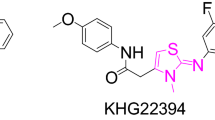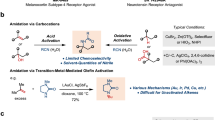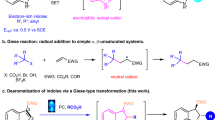Abstract
This protocol describes a rapid, high-yielding, microwave-mediated route that affords benzazole heterocycles in high crude purity and represents a significant advancement toward an environmentally friendly reaction. The reaction of aryl isothiocyanates with o-nucleophilic anilines produces thiourea intermediates that, in the presence of a carbodiimide-functionalized resin, cyclize to benzazoles with the safe removal of one equivalent of hydrogen sulfide. This procedure takes ∼8.5 h to complete: 1–3 h for setup, 4.5 h for benzazole formation and 2 h for workup and purification.
This is a preview of subscription content, access via your institution
Access options
Subscribe to this journal
Receive 12 print issues and online access
$259.00 per year
only $21.58 per issue
Buy this article
- Purchase on Springer Link
- Instant access to full article PDF
Prices may be subject to local taxes which are calculated during checkout





Similar content being viewed by others

References
Martin, E.J. & Critchlow, R.E. Beyond mere diversity: tailoring combinatorial libraries for drug discovery. J. Comb. Chem. 1, 32–45 (1999).
Neyts, J. et al. Structure-activity relationship of new anti-hepatitis C virus agents: heterobicycle-coumarin conjugates. J. Med. Chem. 52, 1486–1490 (2009).
McInnes, C. et al. Inhibitors of Polo-like kinase reveal roles in spindle-pole maintenance. Nat. Chem. Biol. 2, 608–617 (2006).
Hayashi, S. et al. Novel non-peptide nociceptin/orphanin FQ receptor agonist, 1-[1-(1-methylcyclooctyl)-4-piperidinyl]-2-[(3R)-3-piperidinyl]-1H-benzimidazole: design, synthesis, and structure-activity relationship of oral receptor occupancy in the brain for orally potent antianxiety drug. J. Med. Chem. 52, 610–625 (2009).
Charifson, P.S. et al. Novel dual-targeting benzimidazole urea inhibitors of DNA gyrase and topoisomerase IV possessing potent antibacterial activity: intelligent design and evolution through the judicious use of structure-guided design and structure-activity relationships. J. Med. Chem. 51, 5243–5263 (2008).
Siracusa, M.A. et al. Synthesis of new arylpiperazinylalkylthiobenzimidazole, benzothiazole, or benzoxazole derivatives as potent and selective 5-HT1A serotonin receptor ligands. J. Med. Chem. 51, 4529–4538 (2008).
Pelletier, J.C. et al. Discovery of 6-({4-[2-(4-tert-butylphenyl)-1H-benzimidazol-4-yl]piperazin-1-yl}methyl)quinoxaline (WAY-207024): an orally active antagonist of the gonadotropin releasing hormone receptor (GnRH-R). J. Med. Chem. 52, 2148–2152 (2009).
Grice, C.A. et al. Identification of a potent, selective, and orally active leukotriene A4 hydrolase inhibitor with anti-inflammatory activity. J. Med. Chem. 51, 4150–4169 (2008).
Lewis, J.C., Berman, A.M., Bergman, R.G. & Ellman, J.A. Rh(I)-catalyzed arylation of heterocycles via C-H bond activation: expanded scope through mechanistic insight. J. Am. Chem. Soc. 130, 2493–2500 (2008).
Rodriguez-Rodriguez, C. et al. Design, selection, and characterization of thioflavin-based intercalation compounds with metal chelating properties for application in Alzheimer's disease. J. Am. Chem. Soc. 131, 1436–1451 (2009).
Gumus, F. et al. Synthesis, cytotoxicity, and DNA interactions of new cisplatin analogues containing substituted benzimidazole ligands. J. Med. Chem. 52, 1345–1357 (2009).
Yuan, Z., Xiao, Y., Li, Z. & Qian, X. Efficient synthesis of regioisomerically pure bis(trifluoromethyl)-substituted 3,4,9,10-perylene tetracarboxylic bis(benzimidazole). Org. Lett. 11, 2808–2811 (2009).
Son, Y.-A., Kim, B.-S., Choi, M.-S. & Kim, S.-H. Characterization of new benz-x-azole dye derivatives and metal complexes. Mol. Cryst. Liq. Cryst. 498, 158–164 (2009).
Kumar, R.V. Synthetic strategies towards benzoxazole ring systems: a review. Asian J. Chem. 16, 1241–1260 (2004).
Mase, T. & Itoh, T. General and practical synthesis of benzothiazoles. Pure Appl. Chem. 80, 707–715 (2008).
Alamgir, M., Black, D.St.C. & Kumar, N. Synthesis, reactivity and biological activity of benzimidazoles. Top. Heterocycl. Chem. 9, 87–118 (2007).
Hausner, S.H. et al. Synthesis of 5- and 6-substituted 2-(4-dimethylaminophenyl)-1,3-benzoxazoles and their in vitro and in vivo evaluation as imaging agents for amyloid plaque. Bioorg. Med. Chem. Lett. 19, 543–545 (2009).
Fujieda, H. et al. Phenylpropanoic acid derivatives bearing a benzothiazole ring as PPARΔ-selective agonists. Bioorg. Med. Chem. Lett. 17, 4351–4357 (2007).
Yen, S.K., Koh, L.L., Huynh, H.V. & Andy Hor, T.S. Formation and structures of Pd(II) N,S-heterocyclic carbene-pyridyl mixed-ligand complexes. J. Organomet. Chem. 694, 332–338 (2009).
Ackermann, L., Althammer, A. & Fenner, S. Palladium-catalyzed direct arylations of heteroarenes with tosylates and mesylates. Angew. Chem. Int. Ed. 48, 201–204 (2009).
Perkins, J.J., Zartman, A.E. & Meissner, R.S. Synthesis of 2-alkylaminobenzimidazoles. Tetrahedron Lett. 40, 1103–1106 (1999).
Mohsen, A., Omar, M.E., Sams El-Dine, S.H.A. & Hazzam, A.A.B. New facile synthesis of 2-substituted aminobenzimidazoles. Pharmazie 30, 85–86 (1975).
Kumar, A., Maurya, R.A. & Ahmad, P. Diversity oriented synthesis of benzimidazole and benzoxa/(thia)zole libraries through polymer-supported hypervalent iodine reagent. J. Comb. Chem. 11, 198–201 (2009).
Chen, Y.-X., Qian, L.-F., Zhang, W. & Han, B. Efficient aerobic oxidative synthesis of 2-substituted benzoxazoles, benzothiazoles, and benzimidazoles catalyzed by 4-methoxy-TEMPO. Angew. Chem. Int. Ed. 47, 9330–9333 (2008).
Merchan, F.L., Garin, J., Melendez, E. & Tejero, T. 2-(2-Benzimidazolylamino)benzothiazoles and 2-(2imidazolidinylidenamino)benzothiazoles. Synthesis 1066–1067 (1982).
Garin, J., Melendez, E., Merchan, F.L., Tejel, C. & Tejero, T. A facile synthesis of dimethyl N-aryldithiocarbonimidates and 2-arylaminobenzimidazoles. Synthesis 375–376 (1983).
Cee, V.J. & Downing, N.S. A one-pot method for the synthesis of 2-aminobenzimidazoles and related heterocycles. Tetrahedron Lett. 47, 3747–3750 (2006).
Boeini, H.Z. & Najafabadi, K.H. Efficient one-step synthesis of benzazoles in aqueous media. Eur. J. Org. Chem. 2009, 4926–4929 (2009).
Ghosh, H., Yella, R., Nath, J. & Patel, B.K. Desulfurization mediated by hypervalent iodine(III): a novel strategy for the construction of heterocycles. Eur. J. Org. Chem. 2008, 6189–6196 (2008).
Lee, H.-G. et al. TBAF-assisted copper-catalyzed N-arylation and benzylation of benzazoles with aryl and benzyl halides under the ligand/base/solvent-free conditions. J. Org. Chem. 74, 5675–5678 (2009).
Heinelt, U. et al. A convenient method for the synthesis of 2-amino substituted aza-heterocycles from N,N′-disubstituted thioureas using TsCl/NaOH. Tetrahedron 60, 9883–9888 (2004).
Dallinger, D. & Kappe, C.O. Rapid preparation of the mitotic kinesin Eg5 inhibitor monastrol using controlled microwave-assisted synthesis. Nat. Protoc. 2, 317–321 (2007).
Dallinger, D. & Kappe, C.O. Automated generation of a dihydropyrimidine compound library using microwave-assisted processing. Nat. Protoc. 2, 1713–1721 (2007).
Bacsa, B. & Kappe, C.O. Rapid solid-phase synthesis of a calmodulin-binding peptide using controlled microwave irradiation. Nat. Protoc. 2, 2222–2227 (2007).
Carpenter, R.D., DeBerdt, P.B., Lam, K.S. & Kurth, M.J. Carbodiimide-based benzimidazole library method. J. Comb. Chem. 8, 907–914 (2006).
Carpenter, R.D. et al. Highly potent, water-soluble benzimidazole antagonist for activated α4β1 integrin. J. Med. Chem. 50, 5863–5867 (2007).
Hayes, B.B., Gerber, P.C., Griffey, S.S. & Meade, B.J. Contact hypersensitivity to dicyclohexylcarbodiimide and diisopropylcarbodiimide in female B6C3F1 mice. Drug Chem. Toxicol. 1, 195–206 (1998).
Witt, K.L., Tice, R.R., Shelby, M.D., Chhabra, R.S. & Zeiger, E. Induction of micronucleated erythrocytes in rodents by diisopropylcarbodiimide and dicyclohexylcarbodiimide: dependence on exposure protocol. Environ. Mol. Mutagen. 33, 65–74 (1999).
Carpenter, R.D. et al. Selectively targeting T- and B-cell lymphomas: a benzothiazole antagonist of α4β1 integrin. J. Med. Chem. 52, 14–19 (2009).
Lunn, W.H.W. & Harper, R.W. Methods for preparing benzimidazo[2,1-b]quinazolin-12-ones and related compounds. J. Heterocycl. Chem. 8, 141–147 (1971).
Carpenter, R.D., Lam, K.S. & Kurth, M.J. Microwave-mediated heterocyclization to benzimidazo[2,1-b]quinazolin-12(5H)-ones. J. Org. Chem. 72, 284–287 (2007).
Kappe, C.O. & Dallinger, D. The impact of microwave synthesis on drug discovery. Nat. Rev. Drug Discov. 5, 51–63 (2006).
Heropoulos, G.A., Cravotto, G., Screttas, C.G. & Steele, B.R. Contrasting chemoselectivities in the ultrasound and microwave assisted bromination reactions of substituted alkylaromatics with N-bromosuccinimide. Tetrahedron Lett. 48, 3247–3250 (2007).
Carpenter, R.D. et al. Halogenated benzimidazole carboxamides target integrin alpha4 beta1 on T and B cell lymphomas. Cancer Res. 70, 5448–5456 (2010).
http://www.mrl.ucsb.edu/mrl/centralfacilities/polymer/mconditions_1.html (accessed on July 2010).
Jochims, J.C. Carbodiimides. IV. New synthesis of aromatic isothiocyanates. Chem. Ber. 101, 1746–1752 (1968).
Acknowledgements
This research is dedicated to the memory of our former colleague A.D. Mills. We thank the National Cancer Institute (U19CA113298), the National Science Foundation (CHE-0910870) and the National Institute for General Medical Sciences (GM089153) for their generous financial support. R.D.C. thanks the American Chemical Society's Division of Medicinal Chemistry for Predoctoral Fellowship support (sponsored by Sanofi-Aventis); the Howard Hughes Medical Institute for the Med into Grad Fellowship; and The University of California, Davis for the R.B. Miller Graduate Fellowship and for the Outstanding Dissertation Award. NMR spectrometers were in part funded by the National Science Foundation (CHE-0443516 and CHE-9808183).
Author information
Authors and Affiliations
Contributions
R.D.C. codesigned and carried out the experiments, wrote the paper and is the corresponding author. M.J.K. co-designed the experiments and provided senior authorship.
Corresponding author
Ethics declarations
Competing interests
The authors declare no competing financial interests.
Rights and permissions
About this article
Cite this article
Carpenter, R., Kurth, M. A rapid and efficient route to benzazole heterocycles. Nat Protoc 5, 1731–1736 (2010). https://doi.org/10.1038/nprot.2010.132
Published:
Issue Date:
DOI: https://doi.org/10.1038/nprot.2010.132
Comments
By submitting a comment you agree to abide by our Terms and Community Guidelines. If you find something abusive or that does not comply with our terms or guidelines please flag it as inappropriate.


